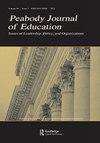满足哪个国家需要的力量?美国教育委员会,联邦支持学生援助,平等教育机会
Q2 Social Sciences
引用次数: 0
摘要
1947年,杜鲁门总统要求高等教育委员会考虑如何扩大所有美国人的教育机会。委员会在HEAD的第二卷中作出了回应,这是一份进步的文件,建议联邦政府大力支持高等教育,特别是以学生援助的形式。美国教育委员会(ACE)在委员会的审议中代表高等教育,并在1947年至1972年期间制定教育政策方面发挥了强有力的作用。它在联邦资助学生资助方面的立场受到院校自治、院校多样性以及高等教育与国家目标之间日益弱化的关系的影响,这使得它难以处理数量与质量之间、消费者与协会责任之间的紧张关系。最终,虽然ACE在第二卷的形成中发挥了核心作用,但在出版后的25年里,它并没有有效地游说联邦学生援助资金。其结果是在现代体系中扩大了准入,而这一体系未能实现杜鲁门委员会的进步承诺。本文章由计算机程序翻译,如有差异,请以英文原文为准。
The Strength to Meet Which National Need? The American Council on Education, Federal Support for Student Aid, and Equal Educational Opportunity
ABSTRACT President Truman asked the 1947 Commission on Higher Education to consider ways to expand educational opportunities to all Americans. The commission responded in Volume II of HEAD, a progressive document that recommended substantial federal support for higher education, particularly in the form of student aid. The American Council on Education (ACE) represented higher education in the commission’s deliberations and had a powerful role in shaping education policy development between 1947 and 1972. Its position on federal funding for student aid was shaped by institutional autonomy, institutional diversity, and a weakening relationship between higher education and national goals, which made it difficult to navigate tensions between quantity and quality and between consumer and associational accountability. Ultimately, while the ACE played a central role in shaping Volume II, it did not lobby effectively for federal student aid funding for 25 years after its publication. The result was expanded access in a modern system that has fallen short of the progressive promise of the Truman commission.
求助全文
通过发布文献求助,成功后即可免费获取论文全文。
去求助
来源期刊

Peabody Journal of Education
Social Sciences-Education
CiteScore
2.20
自引率
0.00%
发文量
43
期刊介绍:
Peabody Journal of Education (PJE) publishes quarterly symposia in the broad area of education, including but not limited to topics related to formal institutions serving students in early childhood, pre-school, primary, elementary, intermediate, secondary, post-secondary, and tertiary education. The scope of the journal includes special kinds of educational institutions, such as those providing vocational training or the schooling for students with disabilities. PJE also welcomes manuscript submissions that concentrate on informal education dynamics, those outside the immediate framework of institutions, and education matters that are important to nations outside the United States.
 求助内容:
求助内容: 应助结果提醒方式:
应助结果提醒方式:


